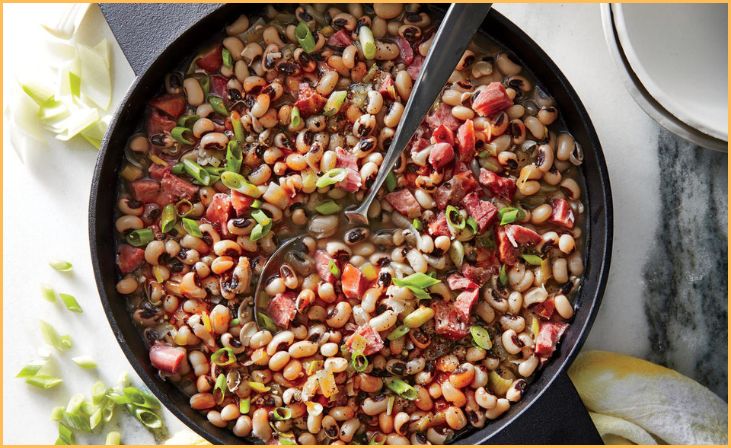As the calendar turns, various cultures worldwide usher in the New Year with unique and meaningful traditions, especially when it comes to food. In this culinary journey, we’ll explore seven distinctive New Year’s food traditions believed to bring good luck, prosperity, and a sprinkle of magic to the year ahead. As the calendar transitions, diverse cultures globally welcome the New Year with special food traditions, adding a unique touch of meaning to the festivities.
Embarking on this culinary journey, we delve into seven distinct New Year’s food customs, each carrying the belief of bestowing good luck, prosperity, and a dash of enchantment upon the approaching year. These traditions transcend mere nourishment, becoming symbolic rituals that connect individuals to their heritage and aspirations. From symbolic ingredients to specific dishes, these culinary practices reflect the cultural richness and the universal desire for a prosperous and magical year ahead. It’s a global celebration where flavors intertwine with tradition, creating a tapestry of culinary customs that not only satiate the palate but also weave stories of hope and optimism for the coming year.
New Year’s Food Traditions for Good Luck
Southern Charm: Black-Eyed Peas for Wealth

In the Southern United States, a New Year’s Day tradition holds profound symbolism in the consumption of black-eyed peas. This practice is deeply rooted in the belief that these legumes, with their distinct appearance, symbolize coins, becoming a harbinger of wealth and prosperity for the approaching year. The tradition is more than a culinary choice; it’s a cultural ritual that transcends generations.
As families gather to partake in this symbolic meal, they embrace the hopeful notion that the act of consuming these humble peas will invite financial abundance and good fortune into their lives. It’s a poignant connection between sustenance and aspiration, where each bite of black-eyed peas is laden with the collective optimism of a community, carrying forward a tradition that binds them to the promise of a prosperous future.
Read Also: Unveiling the Magic: Can Almond Oil Help with Dark Circles? How to Use It
Green and Glorious: Collard Greens and Kale
In diverse cultures, the New Year’s tradition of consuming greens, such as collard greens or kale, carries a symbolic connection to prosperity. This practice, observed across various communities, finds its roots in the belief that the vibrant green hue of these leafy vegetables represents money. The act of partaking in this annual leafy feast is seen as a ritual to invite financial fortune for the upcoming year.
Beyond its nutritional value, the color of money associated with these greens transforms the act of eating into a symbolic gesture, weaving together tradition and aspiration. Families and individuals, united in this shared custom, embrace the hope that the verdant greens on their plates will translate into a year filled with abundance and financial well-being, making each bite a flavorful step into a prosperous future.
Rooting for Progress: Pork Symbolism
In numerous New Year’s food traditions, pork assumes a central role, embodying symbolism tied to progress and prosperity. The focus on pork stems from the unique behavior of pigs, which root forward while foraging. This distinctive characteristic aligns with the cultural belief that consuming pork on this auspicious day imparts a sense of forward motion to individuals, symbolically propelling them towards advancement in the upcoming year.
Beyond the culinary delight, the choice to include pork in New Year’s festivities becomes a metaphorical gesture, emphasizing the collective desire for positive momentum and prosperity. Families partaking in this tradition find significance in the notion that, much like the determined forward motion of the pig, their consumption of pork acts as a catalyst for progress, laying the foundation for a year marked by achievement and success.
12 Months of Prosperity: Round Fruits in Filipino Culture
In Filipino culture, a charming New Year’s tradition unfolds with the symbolic arrangement of 12 round fruits on the table, each intricately tied to a specific month of the year. This custom, rich in meaning, is rooted in the belief that the round shape of these fruits possesses the power to attract prosperity and wealth throughout the coming months. The choice of 12 fruits, mirroring the months in a year, creates a cyclical representation of time and abundance.
As families gather around this fruit-laden table, they engage in a ritual that goes beyond the sensory pleasure of consuming these fruits; it’s a visual and symbolic feast embodying hope and anticipation. The roundness of the fruits becomes a metaphorical gesture, inviting a continuous and bountiful cycle of good fortune in the unfolding chapters of the year ahead.
Completing the Circle: Ring-Shaped Foods

In the realm of New Year’s traditions, foods crafted in circular shapes, exemplified by doughnuts, carry profound symbolism. The circular form of these treats holds a unique significance, representing the idea of coming full circle—the conclusion of one year and the inception of another. Beyond their delectable nature, these ring-shaped foods encapsulate the essence of completion, continuity, and the perpetual cycle of time.
As individuals partake in these symbolic treats during the New Year’s festivities, they embrace the belief that the circularity embodies good fortune and the seamless transition from the past to the future. It’s a culinary metaphor that resonates with the hopeful spirit of new beginnings, where the act of indulging in these circular delights becomes a tangible and flavorful celebration of the cyclical nature of time and the anticipation of what lies ahead.
Strands of Longevity: Asian Long Noodles
In several Asian cultures, the tradition of indulging in long noodles on New Year’s Day is steeped in a profound belief in longevity. Beyond their culinary appeal, the length of these noodles carries symbolic weight, representing a heartfelt wish for an extended and prosperous life in the approaching year. This custom reflects a cultural reverence for the interconnectedness of food and symbolism. As families gather around tables adorned with these elongated strands, they participate in a ritual that transcends mere nourishment.
The act of consuming long noodles becomes a tangible expression of the collective aspiration for a sustained and thriving existence. It’s a culinary gesture that ties the present to the future, weaving together the threads of tradition, symbolism, and the universal desire for health and prosperity as individuals embark on the journey of another year.
Read Also: 8 Advantages of Rubbing Banana Peel On Your Face
Hidden Fortune: Vasilopita, the Greek New Year’s Cake

In the festive traditions of Greece, the New Year brings forth a delightful custom featuring a special cake known as Vasilopita. What sets this cake apart is the element of surprise—a hidden coin nestled within its layers. The significance goes beyond the culinary delight; the person fortunate enough to discover the coin in their slice is believed to be bestowed with good luck for the entire year.
This cherished tradition adds an element of excitement and anticipation to the New Year’s celebration as families and friends gather to partake in the cutting of the Vasilopita. Beyond its sweet taste, the cake becomes a vessel of fortune, embodying the spirit of hope and unexpected blessings as the revelry of the new year unfolds.
Bottom Line
As we savor these delightful traditions, it’s a reminder that food has the power not only to nourish the body but also to bring cultural richness and meaning to our lives. Embracing these New Year’s food customs is a celebration of diversity, unity, and the shared hope for a prosperous year ahead. As we embark on the journey of a new year, these seven New Year’s food traditions bring more than just culinary delights—they carry the weight of cultural symbolism, hope, and the universal desire for good luck.
From the symbolic roundness of fruits to the long noodles signifying longevity, these traditions weave a tapestry of beliefs and aspirations around the dining table. Whether it’s the hidden coin in the Vasilopita or the circular form of doughnuts, each tradition adds a unique flavor to the celebration, connecting us to age-old customs that transcend borders. As we savor the symbolic dishes, let us embrace the shared optimism they represent, weaving a narrative of prosperity, good fortune, and the promise of a joyous and fulfilling year ahead.
FAQs
Black-eyed peas are believed to resemble coins and symbolize wealth and prosperity for the coming year in the Southern United States.
Placing 12 round fruits on the table, each representing a month, is a Filipino tradition symbolizing a wish for prosperity throughout the entire year.
Long noodles symbolize a wish for longevity, reflecting the belief in a prolonged and prosperous life in the coming year.







